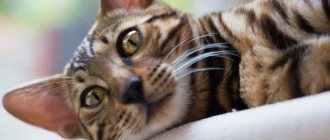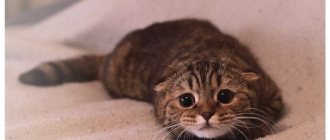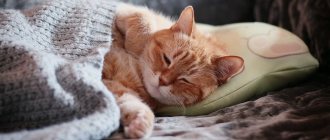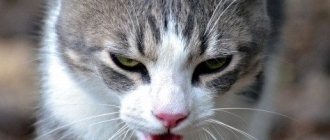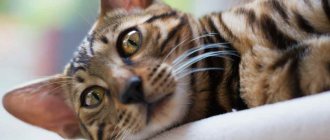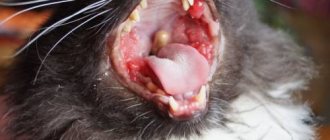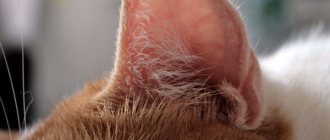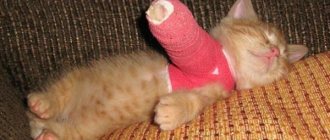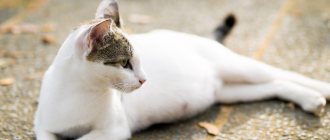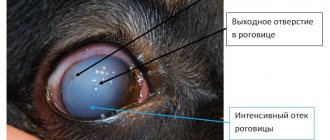Symptoms of heart problems
How can you even understand that your pet has some kind of heart problem?
The problem is that cats are notorious couch potatoes. And if “problems” in the behavior of the same dogs quickly become obvious during regular walks, a cat’s illness can remain completely unnoticed for a long time. However, you may notice that your pet has become more “lazy” and tries not to move unless absolutely necessary. If the cat “deigns” to walk to the bowl, it is not difficult to notice that such a simple action was not easy for him: the animal begins to choke, wheeze and cough.
It is no coincidence that veterinarians consider early diagnosis of heart pathologies in cats to be a difficult and thankless task. Often there are no clinical signs at all. Until the pet’s body passes some “critical point”, after which the symptoms begin to increase exponentially.
As for the characteristic signs of cardiac pathologies, these include:
- difficulty breathing; wheezing;
- severe shortness of breath that occurs even after light physical exertion;
- in severe cases (even without a phonendoscope), you can hear something gurgling and bubbling noisily in your pet’s chest. These are very alarming signs indicating the presence of profuse effusion in the chest cavity. The fluid compresses the lungs and heart, causing all the breathing problems described above to develop;
- severe hypothermia of the limbs and other parts of the body (for example, ears and paws);
- paleness of all visible mucous membranes (gums and eyes). All this indicates a serious deterioration in blood circulation in the animal’s body;
- in severe cases (often when the cat is already dying), the skin over the entire surface of the body becomes cold.
Note that coughing with heart disease is not typical for cats. This sign is more often observed in sick dogs. It is highly likely that in cases where your cat is coughing uncontrollably and panting heavily, the heart has nothing to do with it. Most likely, we are talking about bronchitis or other lung diseases.
Treatment of a pet who has had a heart attack and prevention of the disease
Treatment of a heart attack in a cat should begin only after an accurate diagnosis. In a veterinary clinic, the animal undergoes diagnostic measures to determine the degree of damage and the condition of the entire body against the background of ischemia.
First of all, a veterinary specialist conducts auscultation (listening), identifying disturbances in the heart rhythm and the possibility of the appearance of heart murmurs. Electrocardiography is necessary to identify true ischemic changes in the myocardium.
Ultrasound is widely used to diagnose myocardial infarction in veterinary medicine. Carrying out instrumental analysis using an ultrasound machine makes it possible not only to assess the condition of the heart, but also to diagnose stenosis in large arteries, as well as hypertrophy in the left ventricle.
For diagnostic purposes, a complete blood count and biochemistry are performed to detect leukocytosis, increased erythrocyte sedimentation rate, and changes in the levels of alkaline phosphatase, amylase, creatinine, and cardiac enzymes. Rarely, X-ray examinations of the chest area are prescribed. It is necessary to exclude hypertrophic cardiomyopathy, arrhythmia, or myocardial defects.
Drug treatment for a heart attack in a cat is prescribed only by a specialist. Self-medication is unacceptable, as it can negatively affect the general condition of the animal. First of all, medications are prescribed to relieve pain. Painkillers such as Ketofen and Ketonal are widely used in veterinary medicine.
If a heart attack is diagnosed, the following are also prescribed:
- antithrombic drugs - Heparin and Warfarin (aspirin is contraindicated for cats);
- sedatives (sedatives) – Kot Bayutn, Fospasim, Fitex;
- diuretics - to relieve swelling and reduce the load on the myocardium (Furosemide, Veroshpiron);
- beta-blockers - increase myocardial function, supply oxygen and increase metabolic processes (Atenol, Metoproloo, Propranolol);
- vitamin complexes (vitamin C, B5, B6, B12).
The further rehabilitation period depends on the correct organization of keeping the animal in the post-infarction state. It is necessary to provide the cat with peace by placing it in a quiet room where the least number of people walk and no one will disturb the pet.
It is important to prevent possible unrest and stressful situations in order not to aggravate the animal’s condition.
It is also necessary to take care of physical activity - it needs to be minimized. The diet should consist of light foods without fat. You can give fermented milk products, lean beef and low-fat varieties of boiled sea fish. Cats fed ready-made food must be switched to a special diet.
It is necessary to select a special ready-made granular or wet food of super-premium class, suitable for pets with heart problems.
It is practically impossible to prevent myocardial infarction in cats. The owner can only minimize risks by adhering to certain rules. A special place is occupied by the organization of the animal’s diet, because obesity is one of the main causes of disorders in the cardiovascular system.
For preventive purposes, it is necessary to enrich the cat’s diet with the essential amino acid taurine, which has a beneficial effect on the animal’s cardiovascular system.
It is important to promptly treat chronic diseases in your pet and undergo preventive examinations by a veterinarian once every six months to a year.
veterinarian - the answer will be sent to your email
Rules of care and feeding
The success of therapeutic measures for myocardial infarction in a domestic cat largely depends on the competent behavior of the owner. First of all, the sick pet is given complete rest. The cat should be placed in a calm and quiet corner of the apartment, protected from the presence of children and strangers. It is good if the room is equipped with a secret darkened place where the animal will feel safe.
A cat that has suffered a myocardial infarction should be protected from psycho-emotional unrest and stress. The atmosphere in the house should be calm and friendly.
The owner should ensure that physical activity is minimal. Quiet short walks in the fresh air in familiar surroundings are recommended. A sick pet needs to review the menu. Food should be light, not greasy.
Preference should be given to fermented milk products, lean beef, and fish. Pureed buckwheat, oatmeal, and rice porridges cooked in water or chicken broth are useful.
Fatty meat and fish, as well as food from the table: sweets, smoked and canned foods, are completely excluded from the diet of a sick cat. On the recommendation of a veterinarian, the animal can be switched to easily digestible super-premium food.
Myocardial infarction in furry pets is a rare but dangerous phenomenon. The insidiousness of the disease lies in the absence of characteristic symptoms and the need for hardware diagnostic methods. Timely and competently prescribed treatment allows the animal to adapt to the new condition. The success of therapy largely depends on proper care and diet.
Diagnosis of myocardial infarction
A veterinary doctor can start thinking about myocardial infarction as soon as he sees the animal, since the symptoms are quite vivid and characteristic.
Thanks to instrumental diagnostic methods (echocardiography, electrocardiography), the veterinarian will carry out a differential diagnosis of a heart attack with other heart diseases that can cause similar symptoms, and will also check for brain diseases.
These are pathologies such as inflammatory diseases of the membranes of the walls of the heart (endocarditis, myocarditis, pericarditis, pancarditis), myocardosis, and various types of cardiomyopathy.
The distinctive features of a heart attack from any other heart disease on the ECG are:
- Pathological ST segment elevation.
- The growth of the Q wave is the main wave indicating the process of ischemia.
- Signs of bundle branch block appear.
An ultrasound can show interruptions in the functioning of the affected chamber of the heart (right and left ventricle).
Prevention available to everyone
It is very difficult to prevent the occurrence of cardiac necrosis in a pet. In addition, veterinarians are rarely able to identify it in time. However, the owner is able to take preventive measures that will help his mustachioed friend remain healthy and active for a long time.
The main component of a strong immune system is good nutrition. An excess of fatty meat will lead to the formation of cholesterol plaques inside the blood vessels. If the drinking regime is disturbed, there is a high risk of blood clots. This occurs due to poor blood clotting.
Taking human medications by a pet without the supervision of a specialist causes blockage of blood vessels and irreversible changes in the body that cannot be corrected. In case of illness, it is necessary to strictly follow the doctor's instructions. He can determine the lack of nutrients in the body by appearance or give recommendations after conducting a comprehensive study.
Recently, there has been a clear opinion among veterinarians and scientists that the main cause of heart disease is a deficiency of an amino acid called taurine. Adding this beneficial component to food leads to a significant reduction in the risk of heart disease in pets.
Creating comfortable living conditions also has a good effect on the pet’s life expectancy. If he lives in a loving family, where he is caressed and cared for, then the cat will receive a minimum of heart-damaging stress. You need to take care of your pet's physical activity. They should be age appropriate and not excessive. You should play with him more often, allow him to walk in the fresh air and protect him from hypothermia.
The article is for informational purposes only. Contact your veterinarian!
Prevention of heart attack in cats
Preventing heart attacks in cats is difficult because it is extremely difficult to avoid. Although this disease is rarely recorded in animals, it still develops. All the owner can do is balance the pet’s diet (nothing fatty). Nutrition should not change metabolism, and plaques should not form in blood vessels. And the blood should not clot too much (otherwise there is a high risk of blood clot formation). So give more water.
In most cases, timely and correct treatment of a cat for a heart attack saves the animal from the sad fate of a disabled person or death. Drug therapy includes procedures such as:
- taking sedatives;
- taking blood thinners;
- taking diuretics;
- cardiac stimulation, etc. at the discretion of the veterinarian.
The animal needs to create the necessary conditions for recovery and ensure peace. Even with a heart attack, cats and cats are prescribed diet therapy. As a rule, these are light, low-fat foods. Still not allowed beef, lamb, liver, cheese.
Remember, the best treatment is prevention. It is better to prevent the development of the disease than to cry later that the mustache is suffering.
By the way, I think you will be interested to know that scientists have not only determined whether cats have a heart attack or stroke, but also found out the cause that causes heart failure. As it turned out, most often the disease develops due to a deficiency of the essential amino acid taurine.
Recently, the efforts of veterinarians and nutritionists in this direction have begun to bear fruit. Nowadays, taurine is added to cat food by default, even without always indicating it on the packaging, which has led to a significant reduction in the incidence of heart disease in our beloved pets.
Video about heart disease in cats:
source
How does the treatment work?
Drug treatment for a heart attack is prescribed to a cat based on symptoms and depending on the characteristics of the course of the disease.
In case of a heart attack, drugs that improve cardiac function are prescribed.
- relieve pain (Ketofen, etc.);
- improve heart function;
- prevent or eliminate blood clots
- remove excess fluid from the body;
- calm the animal (drops and tablets Kot Bayun, etc.);
- introduce heart-healthy vitamins and elements into the body.
A key role in treatment is played by the special conditions created for the sick animal. The cat needs complete peace, silence, fresh air without drafts, and the opportunity to retire in a darkened “hole.”
The food should be light and the diet should not contain dangerous food for cats.
You can offer pussy:
- liquid porridges cooked in milk or chicken broth (semolina, finely ground oatmeal or buckwheat);
- baby food - heated porridge without sugar, pureed chicken and vegetables (preferably with zucchini because of their diuretic effect);
- kefir, fermented baked milk, children's cottage cheese;
- special dietary foods of the premium segment.
The absence of fatty meat, sweets, cheese, sausages, and other salty foods in the diet will help the functioning of the cardiovascular system. If your cat is on dry food, it is advisable to avoid cheap food.
Treatment prescribed by a veterinarian
The veterinarian begins urgent measures to prevent an attack and its consequences immediately after an accurate diagnosis. Drug therapy for heart attacks in cats is prescribed only by a specialist. Self-medication is unacceptable, because it can have a bad effect on the general condition of your mustachioed friend.
First of all, medications are prescribed to relieve pain. Painkillers such as Ketofen and Ketonal are popular in veterinary medicine.
In case of diagnosed illness, the following are used:
- drugs against blood clot formation - Heparin and Warfarin;
- sedatives, sedatives - Kot Bayutn, Fospasim, Fitex;
- diuretics that help remove swelling and reduce the load on organs - Furosemide, Veroshpiron;
- adrenaline beta blockers, which increase myocardial function - they supply oxygen and help increase metabolic processes - Atenolol, Metoprolol, Propranolol;
- complexes of vitamins C, B5, B6, B12.
At any stage of a heart attack in cats, a drip with a water-salt solution is used to help protect the body from dangerous dehydration. For this purpose, injections are given from saline or glucose solution, doing them in turn.
Severe pain syndrome rarely goes away on its own, and without adequate medical care the patient almost always dies. If the use of analgesics was timely, the discomfort in the sternum will disappear in a couple of minutes.
Heart attack in cats
Heart attacks also happen in cats. It sounds terrible, but no one is immune from illness. And it is impossible to predict when and what your pet will get sick with. This is easier for people: they had a heart problem, they went to the doctor and managed to prevent trouble. But with animals everything is much more complicated. They won’t tell you where, how long ago and how much it hurts. And often owners notice symptoms of heart disease in a cat too late.
Myocardial infarction in cats, although a rare occurrence, does occur. And there are as many dangers for the health and life of a pet as there are for humans. And all because myocardial infarction is the death of a section of the heart muscle. Because of this, the heart stops functioning normally. And the whole body seems to “fall apart.” Without proper treatment, the mustache will die.
Useful video
To learn what to look for when choosing food for your pet, watch this video:
A heart pathology called hypertrophic cardiomyopathy is less common in cats.
Of the many cardiac problems, the most common in cats is defects in the development of the heart muscle.
Congenital and acquired heart diseases in cats. Pets are susceptible to various ailments from birth and throughout their lives.
Causes and types of disease
The factors that provoke myocardial infarction in cats are very diverse. Disturbances in the functioning of cardiac muscle tissue can be caused by congenital or acquired causes. In this regard, they talk about four types of pathology:
- Transmural subtype
characterized by widespread damage to the myocardial muscle.
- Intramural type
affects the thickness of the walls of the ventricle located on the left side, without affecting the endocardium.
- Subendocardial type
aimed at a narrow line in the area of the left ventricle.
- Subepicardial view
characterized by lesions near the epicardium.
Depending on the size of the affected area, the lesions are large-focal and small-focal.
The ancestors of the domestic pet, like their closest relatives, always tried to hunt from ambush. It was unusual for them to pursue prey for a long time. Because if a representative of the cat family experiences prolonged physical activity, he develops tachycardia. The same applies to a domestic cat, therefore, if he plays too much, the volume of blood in the circulatory system becomes less. This further leads to a decrease in pressure, and in advanced cases, to cell death.
Poor myocardial function occurs in juveniles and adults. The former suffer from pathologies in the cardiovascular system due to congenital problems during the intrauterine development of atrioventricular organs and disorders in the blood vessels. Aging cats are susceptible to defects acquired with age that provoke necrosis of the myocardium.
There are a number of additional factors that cause heart attacks in cats:
- Inflammation occurring in blood vessels. Vasculitis occurs systematically and appears due to processes of an autoimmune nature. Changes in the vascular walls lead to severe changes in metabolism and push towards the development of an acute form of the disease.
- Thromboembolism is blockage of the lumen in a vessel by foreign bodies: cells of a malignant or benign tumor, parasites, blood clots, air bubbles due to poorly performed surgery or when drugs are administered intravenously.
- Problems with the endocrine system. The cause of a heart attack in cats can be diabetes mellitus, as well as abnormally high secretion of hormones by the thyroid gland.
- Chronic diseases of the lungs and heart.
- Infection with pathogenic fungi or harmful microorganisms. For example, necrosis can be provoked by purulent inflammations - pyometra, pyelonephritis, glomerulonephritis.
- Bleeding due to surgery or injury that leads to irreversible damage to the cardiovascular system.
- Increased pressure inside the arteries leads to overload in the myocardium, provoking the onset of a destructive process.
- Poisoning with toxic substances: salts of heavy metals, phosphorus-containing substances, poisons. This affects the functioning of all internal organs.
The reasons that cause the development of a heart attack in a cat can indirectly include the animal’s light physical activity and a sluggish lifestyle. Excess weight also has a bad effect on the oxygen supply to muscles.
Emotional stress and stress have a negative impact on your pet’s health.
With an incorrect diet, a deficiency of an important amino acid occurs. A poor supply of taurine leads to the formation of cholesterol plaques.
However, cats rarely suffer from such severe disorders, which lead to thickening of the vascular walls. Often, even elderly individuals retain the heart muscle in good condition. In most reported cases, such a pathology is an irreversible congenital defect.
Rupture of the heart, myocardium: prerequisites, forms, signs, help, prognosis
This pathology develops in the event of a trophic disorder, which leads to congestive cardiomyopathy and hypertrophy of the heart muscle.
The most common causes that lead to the development of cardiac pathology are congenital heart defects. The development of the myocardium in cats is also facilitated by vasculitis, in which inflammation of the walls of blood vessels is noted, which leads to disruption of blood flow and necrosis of the cellular structures of myocardial tissue.
A heart attack can be caused by:
- blockage of the lumen of coronary vessels and arteries by helminths, thrombus, embolus, foreign bodies; the presence of neoplasms on the walls of blood vessels;
- atrioventricular valve defects;
- genetic diseases, congenital pathologies, vascular anomalies;
- infectious, viral, bacterial infections, chronic inflammatory processes occurring in the lungs, heart (bacterial endocarditis);
- hyperthyroidism, disruption of the endocrine system;
- various toxic conditions.
Without exaggeration, the heart is considered the main organ in the circulatory system, without which blood delivery to the internal organs is impossible. When it is damaged, hemodynamics are disrupted, and cardiac rupture (HR) makes blood movement impossible, and the patient dies from shock.
Rupture of the heart muscle - myocardium is a violation of its integrity, which most often occurs due to a heart attack. Contrary to popular belief, fright or severe fear cannot cause a rupture on its own, because the heart is a powerful muscular organ, and for its damage prerequisites are needed in the form of changes in the myocardium.
Elderly people, especially women, as well as patients suffering from diabetes, hypertension, and chronic cardiac ischemia are more susceptible to heart rupture. Taking certain medications and late initiation of treatment for a heart attack may be accompanied by a slowdown in scar formation, which creates the preconditions for rupture.
Among the causes of heart rupture are:
- Heart attack;
- Chest injuries;
- Inflammation of the inner lining of the heart;
- Neoplasms;
- Congenital heart defects;
- Exchange disorders.
The reasons for rupture of the heart wall lie in structural changes, because healthy myocardium is quite strong and, at the same time, elastic, so it cannot rupture.
The most common cause of heart rupture is infarction (necrosis) of the heart muscle. With this disease, rupture occurs in approximately 3% of cases and in approximately half of the patients it occurs on the first day from the onset of necrosis. Over the next two weeks, the likelihood of rupture increases significantly.
With myocardial infarction, rupture of the left ventricle of the heart usually occurs, since it is this section that experiences the greatest load during the operation of the organ, and it is in it that necrosis usually appears. Up to 3% of cases may be accompanied by a violation of the integrity of the septum between the ventricles.
The precursor to rupture is an extensive infarction, affecting a significant volume of the heart muscle, and the risk of damage is maximum in the first two weeks. The right sections and atria are ruptured extremely rarely.
Endocarditis (inflammation of the inner layer of the heart), tumors, metabolic disorders (amyloidosis) lead to changes in the condition of the heart muscle, which becomes very susceptible to stress and can rupture.
Other causes of heart wall rupture include trauma. For example, in case of an accident, a knife wound, a strong blow in certain sports or a fight.
Many people think that there is a rupture of the heart from fear, and this is evidenced by cases of sudden death with severe emotional shock. Indeed, with a post-mortem examination of the heart, it is possible to diagnose its tamponade from a rupture, but the cause of a defect in the myocardium is more often a heart attack, which, among other things, can be provoked by stress, fear, or severe anxiety.
In addition to the immediate causes, there are also predisposing factors:
- Old age - after 50 years, regeneration processes slow down, and most people of this age already have some signs of ischemia or wear and tear of the heart muscle;
- High blood pressure, creating additional stress on the myocardium;
- Delayed treatment of acute infarction;
- Early activation of the patient with extensive heart attacks - even walking on the street or walking around the ward requires an increase in myocardial work, so the motor mode is usually limited;
- Exhaustion and low body weight of the patient contribute to slower scar formation in the necrosis zone, which is fraught with rupture in the acute period of a heart attack;
- Taking medications containing hormones, as well as non-steroidal anti-inflammatory drugs, slows down the formation of connective tissue at the site of the infarction.
Depending on the area undergoing rupture and the time of manifestation of the pathology, various types of heart rupture are distinguished. Depending on the location of the damage zone, the following are possible:
- External ruptures, when a through defect is formed in the wall of the heart, through which blood enters the heart sac.
- Internal ruptures, when the structures of an organ located inside it are damaged: rupture of the papillary muscles, formation of a defect in the septum.
The blood inside the heart moves under high pressure, and when defects appear in the myocardium, it immediately rushes into the cavity of the heart sac, limited by the pericardium. The rapid filling of the pericardial cavity with fluid disrupts the contraction of the heart, causing tamponade and cardiac arrest. There is a deficiency of blood flow in the organs, and the patient dies from shock.
Internal ruptures can occur more easily than external ones. Thus, with a partial rupture of the papillary muscle, the patient can live up to two weeks, but this condition anyway requires urgent surgical treatment.
Incorrect movement of the valve leaflets when the papillary muscles or chordae are damaged causes acute heart failure and is fatal. Ruptures of the septum are accompanied by the movement of blood through the defect from the left half of the heart to the right and can also lead to the death of the patient.
If the rupture occurred within three days from the moment of necrosis or injury, then it will be called early. After 72 hours, when recovery processes have already begun, but the scar is very tender, the rupture is provoked by excessive physical activity and is called late.
With extensive heart attacks, a simultaneous rupture is possible, and then death occurs suddenly. If the defect does not extend to the entire depth of the myocardium or is relatively small, then immediate death does not occur, blood circulation progressively worsens, and the damage is called slow flowing.
How does MS manifest?
Symptoms of cardiac rupture depend on the area of damage in the myocardium, the presence of hemopericardium, and the degree of hemodynamic impairment. With a relatively small defect, when blood does not enter the cavity of the cardiac membrane or its amount there is insignificant, the signs of the disease increase over several hours, ten minutes, and the patient is bothered by:
- Sharp, very intense pain behind the sternum, in the heart;
- Severe anxiety, possibly psychomotor agitation;
- Dyspnea;
- Blueness of the skin;
- Swelling.
As the symptoms of acute heart failure progress, the pulse becomes thready, blood pressure drops, and a change in consciousness or even loss of consciousness is possible. Pain appears in the right hypochondrium, associated with an enlarged liver due to stagnation of venous blood, and swelling increases.
A patient with slowly progressing MS is restless, tries to relieve pain with the usual nitroglycerin, but does not get any effect, the pain may decrease somewhat, but then appears again. Characterized by cold clammy sweat, palpitations and hypotension.
Harbingers of heart rupture can be intense pain that is not relieved by nitroglycerin and even narcotic analgesics, blood pressure drops sharply, the pulse becomes thread-like and can be palpated with great difficulty, the patient turns pale, the skin becomes bluish, and consciousness becomes confused.
Symptoms of external rupture are reduced to signs of pericardial hemotamponade and acute heart failure:
- The patient loses consciousness;
- The neck veins swell, swelling increases;
- Severe cyanosis appears;
- Severe shortness of breath gives way to respiratory arrest;
- The pulse cannot be felt, hypotension is replaced by shock with a lack of pressure.
Hemotamponade of the pericardium is possible not only with ruptures due to a heart attack, but also with traumatic injuries of the heart, rupture of the aorta in its initial section. Sudden pain and signs of cardiogenic shock are the main manifestations of hemotamponade.
Such symptoms increase over several minutes, after which death occurs from a ruptured heart - the pupils do not respond to light, breathing and heartbeat are not detected, and there is no consciousness. The ECG at this moment will show an isoline, that is, a complete absence of cardiac activity.
Myocardial damage does not occur unnoticed, and the risk of dying from cardiac rupture increases significantly if a large-focal transmural infarction is diagnosed, especially against the background of arterial hypertension and in an elderly patient.
Internal ruptures are no less dangerous than external ones. Thus, a violation of the integrity of the papillary muscles of the left ventricle is fraught with the rapid development of pulmonary edema - the main complication when blood flow in the left half of the heart is disrupted.
Preventive actions
To prevent myocardial infarction in cats, it is important for owners to provide the animal with moderate physical activity in the fresh air. If you send your pet outside or you can’t go for a walk with him, you can set up a house for your cat with toys on the balcony
Playing with cat objects increases the load on the heart, making the heart muscle stronger and less susceptible to an attack.
An important preventative measure is the hygiene of the animal and keeping its tray clean. A cat's litter box contains a variety of parasites, so it is important to clean it after each pet's bowel movement.
In addition, the owner needs to diversify the animal’s diet and include foods containing sufficient amounts of vitamins and minerals.
Veterinarians advise giving cats boiled potatoes, legumes, fish and dairy products. The animal can also obtain useful substances from vitamin-mineral complexes, which are given in the spring and autumn. You can buy them in pharmacy chains. Owners should also regularly visit a veterinarian with their cat, which will allow them to identify any pathologies of the cardiovascular system at the initial stages of development, carry out their timely treatment and prevent the development of serious complications that can even lead to death.
This is also interesting!
Among the heart diseases among the most beloved pets is heart attack. Yes, no matter how terrible it may sound, pussies also suffer from heart pathologies. And while a person, feeling pain, rushes to the hospital, where entire teams of cardiologists, therapists and the most modern equipment are at his service, his tailed friend stoically endures all health problems, without being able to complain. That's why owners who are not too attentive sometimes realize it too late, when their beloved animal is already in the complete grip of a terrible disease.
Fortunately, myocardial infarction is rare in pussies. And, nevertheless, it happens, which means it carries a mortal danger. After all, the disease leads to atrophy of the heart muscle, and without the heart life is impossible, everyone knows this. An animal sometimes dies before a person has time to understand what happened to it.
Age. Time is the most terrible enemy of all living things. As an animal ages, it undergoes hormonal changes. It is becoming increasingly difficult for organs, including the heart, to perform their functions. And physical stress contributes to even greater wear and tear on the pet’s main driving force, its heart. Therefore, there must be moderation in everything. Even if your pet is ready to actively play with you, you should not drive him too much. The physical condition of the animal no longer allows it to cope with such a load.
Diet. An incorrectly designed menu throughout the pet’s life leads to the formation of a cholesterol layer on the blood vessels. This complicates their blood supply and causes a deficiency of oxygen, which, as is known, is a symbol of life. Without it, cells die, and this is a direct path to myocardial infarction in the pussy.
Thrombus. Blood clots that form in the vessels can break off and block the flow of blood. This also leads to cellular oxygen starvation and the development of a cat’s heart attack.
Other reasons. Diseases of the vascular system, inflammation, including those of infectious origin, genetic abnormalities, and other factors can provoke myocardial infarction in a pet.
A heart attack can be primary, spontaneous and repeated, cyclical and recurrent, protracted. Possible coronary death.
- pre-infarction;
- the most acute stage (from a quarter of an hour to 2 hours);
- acute infarction with the formation of a necrotic focus (from 2 hours to 2 weeks);
- subacute period - granulation and the beginning of scarring of the necrotic lesion (from 1 to 2 months);
- post-infarction
Sometimes cats experience several types of heart attack simultaneously or sequentially. Major heart attacks are rare in cats, but they are not excluded. This is a very serious condition for the animal and can cause death. There can be no talk of any self-medication.
First aid from the owner
The first thing to do if you suspect a heart attack is to call your veterinarian. According to the symptoms described by the owner, he will recommend giving the animal Corvalol or another drug.
IMPORTANT! You should not give any medications without a doctor’s instructions, otherwise your pet’s condition will only worsen!
What to do next:
- Provide the cat with complete rest - do not shift him or disturb him, do not make noise near him.
- The room in which the patient is located should be well ventilated; extreme heat and stuffiness should not be allowed.
- It is highly advisable to have a veterinarian come to your home. If this is not possible, ONLY use a carrier with a hard plastic bottom.
- Do not give water or food to the patient; if the veterinarian recommends any medications over the phone, give them strictly in liquid form or in the form of an injection.
Remember that you can’t help anything at home, so you definitely need to show the sick person to a specialist.
Nutrition during a heart attack
For successful treatment, you need not only to take the drug on time, but also to provide the cat with a balanced diet. It is immediately necessary to exclude dangerous food for cats: sweets, raw meat or fish, flour products, fatty dairy products, sausages, spices.
A proper diet should include the following foods:
- porridge (you can cook finely ground buckwheat or oatmeal in chicken broth or milk);
- pureed chicken or vegetables, possibly baby food;
- premium-class dietary foods;
- cottage cheese, fermented baked milk or kefir.
You should not force feed your pet. If the cat refuses to eat for a long period of time, then a veterinarian’s consultation is necessary.
After returning home, the animal should rest more time and move less.
The success of therapy depends not only on the recommendations of the veterinarian and prescribed medications, but also on the owner who will care for the pet at home. After the heart attack has been suffered, the cat will need to create conditions of complete rest.
The animal is sent to a quiet and dark room where it will not be disturbed by other pets or children. It is important to protect the cat from stressful situations. In addition, owners should ensure that the cat's activity is limited.
Veterinarian Andrei Gennadievich Komolov recommends walking the animal on the street, where the environment is calm and familiar. Walks should be short so that the animal does not get tired. In addition, you will definitely need to change the cat's diet.
The menu includes foods that are easily digestible. It is forbidden to give cats fatty foods; it is better to avoid using dry food, which is sold in stores. The diet is enriched with fermented milk products.
If the kitten is small, it is acceptable to give it milk. For older animals, low-fat cottage cheese and sour cream are suitable. In addition, it is allowed to feed cats fish, but in limited quantities. Lean types of meat - chicken, beef - will be useful.
You can add cereals to your diet, such as rice and buckwheat. You will need to cook them in weak broth or water. It is forbidden to give pets fatty meats, smoked meats, and sweet foods. If the veterinarian allows it, it is permissible to give the animal easily digestible complementary foods.
Symptoms of the disease
The main symptoms characteristic of a heart attack in cats:
- pain in the left paw in the elbow area, manifested in lameness;
- painful chest;
- a state of anxiety, excitement, often accompanied by meowing;
- pallor, cyanosis of mucous membranes and skin;
- dyspnea;
- dilated pupils;
- severe weakness that replaces excitement;
- lack of appetite;
- poor coordination of movements, unsteady gait;
- presence of arrhythmia;
- increased heart rate.
All of the above symptoms may be present at the same time. However, the presence of only some of them cannot be ruled out.
Symptoms of heart problems
The difficulty in early detection of serious pathology of the heart muscle lies in the absence of characteristic clinical signs. In veterinary medicine, it is customary to treat a disease in stages.
The pre-infarction period is asymptomatic and only in rare cases can it manifest itself as signs of cardiovascular failure: shortness of breath, pallor or blue discoloration (cyanosis) of the mucous membranes, fatigue. The pet can breathe with an open mouth, which is unnatural for cats.
With the development of the most acute and acute stages, the clinical picture becomes more pronounced
Veterinary experts recommend that owners pay attention to the following symptoms in their furry pet:
- Pain syndrome. Due to severe chest pain, which develops as a result of necrosis of a section of the heart muscle, the cat becomes restless, nervous, and aggressive. The state of excitement can be replaced by weakness and apathy. The cat screams a lot, meows, and sometimes screams heart-rendingly.
- The animal's pupils are dilated.
- When palpated, there is pain in the chest.
- Pain and discomfort in the left side of the chest lead to lameness in the animal.
- Impaired blood supply leads to pallor or a bluish tint to the visible mucous membranes (gums, mouth).
- No appetite.
- The animal loses orientation in space, the gait becomes uncertain and shaky. The cat lies down and reluctantly gets up.
- Not only the work of the heart is disrupted, but also the lungs. The cat has shortness of breath and heavy breathing.
- Arrhythmia, tachycardia.
At the subacute stage, pain disappears and symptoms fade away. The post-infarction phase is characterized by the formation of a scar and the adaptation of muscle tissue to work in conditions of decreased organ function.
Symptoms of the disease
A heart attack in cats does not have brightly colored signs. Moreover, not every experienced owner will be able to determine that the animal is on the verge of a seizure. It is important to understand that sometimes the death of a cat occurs in a split second, without any previous symptoms. But it is necessary and important to know the signs of the onset of an attack in any case, this will help gain time and save the cat. Moreover, the assessment of the pet’s condition must be carried out comprehensively. As with any other heart-related disease, delay is unacceptable here. Therefore, the owner must be very attentive to the pet, which is at risk of myocardial infarction.
Let's look at the symptoms of myocardial infarction in more detail:
- The animal cannot “breathe”, and the breathing itself is heavy. A similar symptom may occur after physical activity. It is due to the fact that respiratory failure also occurs against the background of cardiac disease.
- Dysfunctions in the functioning of the heart lead to cyanosis of the mucous membranes. They acquire a characteristic bluish tint.
- Loss of movement coordination. The cat prefers not to move, lies in one place, and reacts extremely sluggishly to signs of attention from the owner.
- Sometimes before a heart attack, your pet may feel severe pain in the chest and left elbow. This will cause him to behave restlessly, meow pitifully and follow the owner everywhere, trying to attract attention.
- There is a sharp increase in heart rate and heart rate changes.
- Painful sensations in the elbow joint cause lameness in the cat's front left paw. Gradually the pain moves completely to the chest area.
- Preliminary symptoms also include the result of an ECG or echocardiograph. With their help, you can accurately determine that the cat has a heart pathology, which will lead to a heart attack in the future.
The owner needs to clearly understand that even if the cat does not have a massive heart attack, it still needs to be taken immediately to a veterinary hospital. To transport your pet, it is best to use carriers that have a solid base. If a veterinarian is expected at home, then it is better not to touch the animal until he arrives, so as not to aggravate the situation.
